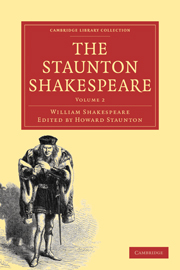Book contents
- Frontmatter
- Contents
- ALL'S WELL THAT ENDS WELL
- KING HENRY THE FIFTH
- AS YOU LIKE IT
- PERICLES, PRINCE OF TYRE
- TWELFTH NIGHT; OR, WHAT YOU WILL
- THE FIRST PART OF KING HENRY THE SIXTH
- THE SECOND PART OF KING HENRY THE SIXTH
- THE THIRD PART OF KING HENRY THE SIXTH
- TIMON OF ATHENS
- KING RICHARD THE THIRD
- MEASURE FOR MEASURE
- KING HENRY THE EIGHTH
- CYMBELINE
CYMBELINE
Published online by Cambridge University Press: 29 August 2010
- Frontmatter
- Contents
- ALL'S WELL THAT ENDS WELL
- KING HENRY THE FIFTH
- AS YOU LIKE IT
- PERICLES, PRINCE OF TYRE
- TWELFTH NIGHT; OR, WHAT YOU WILL
- THE FIRST PART OF KING HENRY THE SIXTH
- THE SECOND PART OF KING HENRY THE SIXTH
- THE THIRD PART OF KING HENRY THE SIXTH
- TIMON OF ATHENS
- KING RICHARD THE THIRD
- MEASURE FOR MEASURE
- KING HENRY THE EIGHTH
- CYMBELINE
Summary
“The Tragedie of Cymbeline” is one of the seventeen plays, the earliest known edition of which is the folio of 1623. When produced, or when first acted, we have, as usual, no means of determining; but Malone is perhaps not far wrong in supposing it was written in 1609, as about that period there is good reason for believing Shakespeare wrote “The Tempest,” and “The Winter's Tale:” and the marked similarity in the versification of those plays and that of Cymbeline, indicates that the three were composed at no distant date from each other.
The main incident of the plot—the wager on the chastity of the heroine—appears to have been taken from a story in Boccaccio (Day 2, Nov. 9), of which an abstract will be found in the “Illustrative Comments.” This novel was a favourite evidently, for it has been translated and paraphrased many times. One modification of it occurs in the amusing collection of stories called, “Westward for Smelts, or The Water-mans fare of mad merry Western wenches,” &c., which Steevens and Malone assert was printed in 1603. If they are correct, this réchauffé of Boccaccio's fable may have contributed to the composition of “Cymbeline,” but no edition of it earlier than 1620, and of that only one copy, is now known to exist. The events in this story are laid in England during the reigns of Henry VI. and Edward IV., and the villain of it, instead of being conveyed to the lady's chamber in a chest (as described in the Italian and French versions), hides himself beneath her bed.
- Type
- Chapter
- Information
- The Staunton Shakespeare , pp. 705 - 771Publisher: Cambridge University PressPrint publication year: 2009First published in: 1859
- 1
- Cited by



